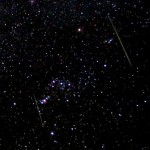The first meteor shower of 2015 is the annual Quadrantid meteor shower. The Quadrantids are a reliable shower, producing 60-120 ZHR, one to two meteors per minute. The Quadrantids are named for the obsolete constellation Quadrans Muralis, now part of the constellation Boötes.

This year’s peak is calculated for January 4th at 08:00UT, this would be January 3rd at 22:00HST for observers in the islands. For northern observers the radiant is circumpolar, thus the shower is observable all night long. Given our 20° latitude here in Hawaii the radiant does not rise until 01:30HST, thus observations must wait until well into the morning hours. A 28% illuminated moon will rise about 02:13 to create some interference in observing the shower. Thus for island observers the predawn hours of January 4th is when you want to observe this meteor shower, this will be several hours after the predicted peak.
The 08h UT timing for the peak will be too late even in the extreme west of mainland Europe while North American observers are in a better position. The λ⊙ = 283.16° maximum timing is based on the best-observed return of the shower ever analysed, from IMO data collected in 1992, as confirmed by radio results in most years since 1996. Typically, the peak is normally short-lived, so can be easily missed in just a few hours of poor northern-winter weather, which may be why the ZHR level apparently fluctuates from year to year. Model calculations of Vaubaillon provide indications that the peak may occur earlier and may show a maximum between January 3, 22h, and January 4, 2hUT. This timing would be optimal for European longitudes. An added level of complexity comes from the fact mass-sorting of particles across the meteoroid stream related to the comet 96P/Machholz and the minor planet 2003 EH1 may make fainter objects (radio and telescopic meteors) reach maximum up to 14 hours before the brighter (visual and photographic) ones, so observers should be alert throughout the shower. – IMO 2016 Meteor Shower Calendar
Watching meteors requires no more equipment than your eyes and a dark sky, and can be enjoyable for just about anyone.

